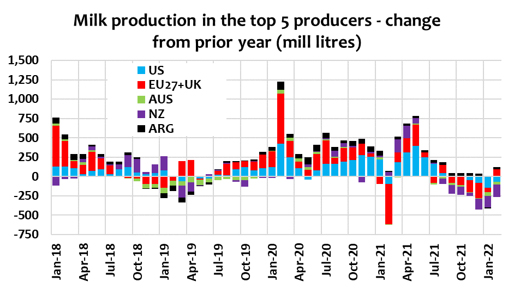Dairy commodity prices have weakened from peaks in Oceania and US, but the EU market remains firm. Supply-side constraints remain a feature in the outlook as the effects of war on feed markets will mean extended periods of high input costs (corn, grain and fertilizer) and weak margins for milk producers. Higher milk prices may alleviate some of the pressure, but most milk producers typically recoil from high costs by reducing inputs rather than looking longer term at their expected business cashflows.
Weather is also not being supportive, as Europe is forecast to have (another) hotter than usual summer, and other regions face a weaker La Nina, while a worsening US drought threatens water supplies.
The effect of the fragile global feed situation will run into next year with the ongoing damage to Ukraine’s food production and sanctions on Russia and its allies. The escalating tensions between Russia, EU and the US have unpredictable consequences.

Uncertainty about EU milk output hangs over protein and fat values keeping wholesale prices firm, but buyers have retreated from strong prices in some developing regions. The higher food (and dairy) prices have not reached many developed world consumers yet – the downward pressure on demand for cheese and butterfat may not significantly affect pricing given the supply constraints in the region.
The fundamentals suggest a tighter US dairy market, subject to the risks for cheese demand as households learn to cope with inflation. While milk production looks to be stabilizing, growth is occurring in limited regions and may soon stall. The US drought is worsening.
China’s zero-COVID restrictions will weaken short-term demand for ingredient imports while domestic whole milk powder output is increasing in the short term. The whip-effect of a stimulated recovery could bring a revival later in the year to recover some lost ground.
By Edwin Lloyd, Executive General Manager – Foods






